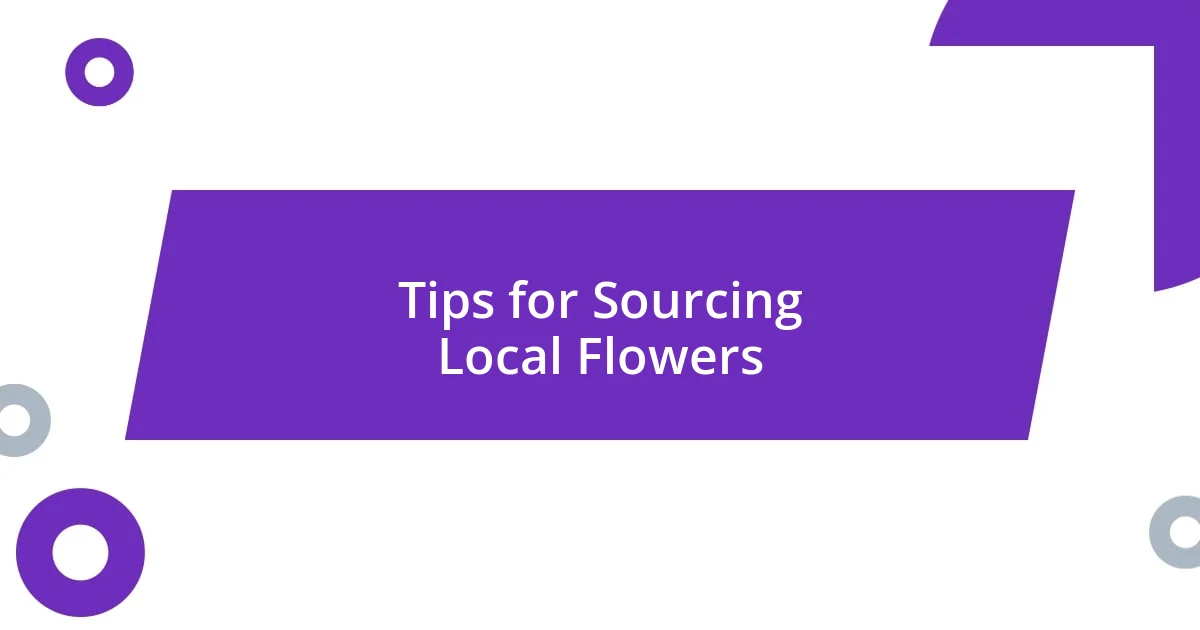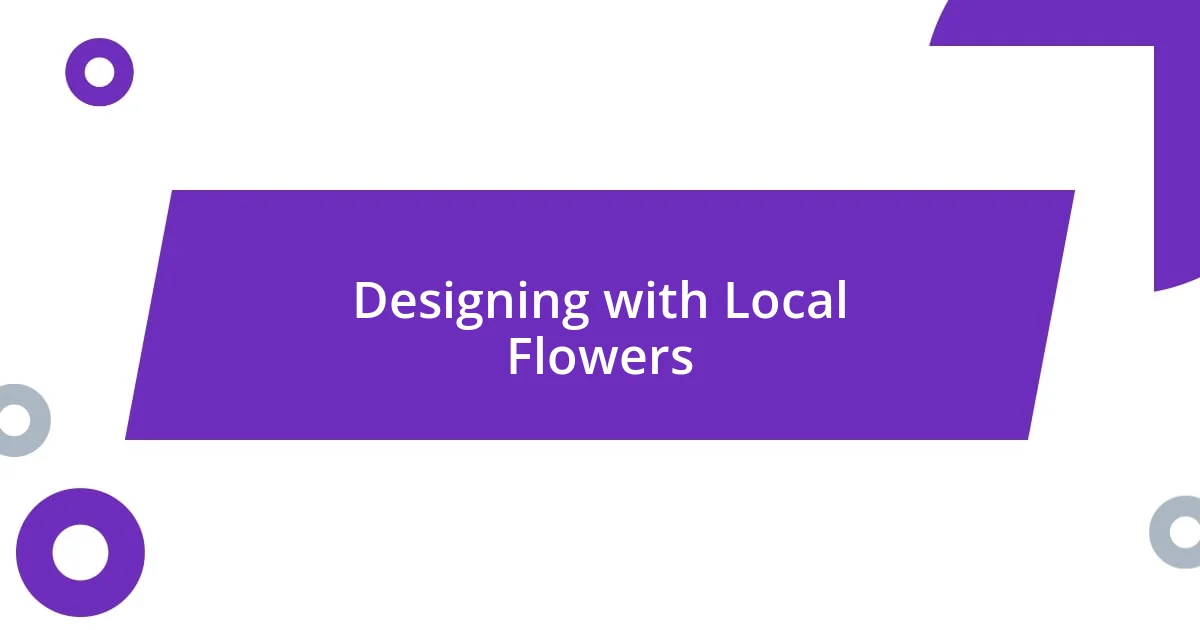Key takeaways:
- Using local flowers enhances arrangements through their freshness, longevity, and unique connection to the surrounding environment, fostering sustainability and supporting local growers.
- Seasonal blooms not only showcase nature’s beauty but bring stories to arrangements; knowing what flowers are in season enhances both creativity and appreciation.
- Caring for local flowers involves proper maintenance, such as trimming stems and providing the right environment, which is crucial for maximizing their beauty and lifespan.

Understanding Local Flower Benefits
Choosing local flowers for arrangements has profound benefits that resonate with me personally. For instance, I still remember the first time I used locally grown sunflowers in my home during late summer. Their vibrant yellows and rich, earthy tones not only brightened my space but also reminded me of the fields I drove by daily. There’s something truly special about using blooms that reflect the essence of your own surroundings.
Local flowers often last longer than imported varieties. When I crafted a centerpiece with locally sourced dahlias, they maintained their beauty for weeks, unlike some store-bought flowers that wilted within days. This longevity not only enhances the aesthetic but also brings a sense of connection to the community I live in—contributing to sustainability and supporting local growers.
Have you ever thought about the ecological impact of using local flowers? By incorporating them into your arrangements, you’re helping to reduce carbon footprints related to transportation. Personally, knowing that I’m making environmentally conscious choices gives me a warm sense of fulfillment, turning each bouquet into a statement of love for the planet while celebrating what our local flora offers.

Choosing Seasonal Local Flowers
When I think about choosing seasonal local flowers, I’m often reminded of my experience at a local farmer’s market in spring. I couldn’t resist the sight of freshly bloomed peonies, their soft petals emanating a delicate fragrance that instantly transported me. I learned over time that seasonal blooms not only showcase nature’s stunning palette but also ensure that I’m getting flowers at their peak freshness and vibrancy.
Here’s a quick guide to seasonal local flowers you might consider:
- Spring: Tulips, daffodils, and hyacinths
- Summer: Sunflowers, zinnias, and cosmos
- Fall: Mums, asters, and dahlias
- Winter: Poinsettias, holly, and evergreen foliage
Having that intimate connection with the rhythm of the seasons enhances my arrangements and deepens my appreciation for the world around me. Each seasonal bloom tells a story, and it’s incredibly rewarding to weave those narratives into my floral designs.

Tips for Sourcing Local Flowers
Gravitating towards local flower sources can significantly enhance your arrangements. I’ve found that attending local flower farmers’ markets not only offers a treasure trove of colorful blooms but also connects you with passionate growers who are happy to share seasonal tips. One afternoon, while chatting with a flower farmer, I learned about the specific varieties that flourished best in my area. That knowledge transformed my flower selections and gave me a personal touch to each arrangement.
Networking with local florists can also be a fruitful way to source gems. I remember visiting a small florist who showcased locally grown flowers in their designs. The owner shared insights into her favorite local growers, and I discovered hidden gems within the community that I would have never found otherwise. It’s amazing how relationships can provide you with a variety of options and even inspire new arrangement styles that reflect local charm.
Lastly, I recommend exploring online platforms that connect consumers directly with local farmers. Websites like Local Harvest opened my eyes to the vast options of seasonal flowers available right in my neighborhood. I’ve experienced the joy of receiving a beautifully curated box of blooms, bringing a bit of the outdoors right to my doorstep, all while supporting local agriculture. Each time I open that box, I’m reminded of the people behind those flowers and the stories they tell.
| Sourcing Method | Benefits |
|---|---|
| Farmers’ Markets | Direct connection to growers and seasonal selection |
| Local Florists | Curated local options and professional insights |
| Online Platforms | Convenience and broad access to local variety |

Designing with Local Flowers
When I begin designing with local flowers, I often feel a sense of excitement as I envision the unique combinations that can emerge. Just the other day, I picked up some vibrant snapdragons alongside delicate sweet peas—can you imagine the visual impact of those lush colors and textures? It’s like each flower brings its own personality to the arrangement, creating a beautiful dialogue that captivates the eye.
As I work with these local blooms, I pay close attention to their natural forms. I remember once arranging a bouquet where the wildflowers danced freely, each reaching out in its own direction. This organic flow made the arrangement feel alive, almost as if it were a snapshot of a wildflower field moved indoors. Isn’t it fascinating how embracing the innate character of each flower can add depth and drama to your designs?
One of my favorite tips for using local flowers is to embrace the imperfections that come with them. A slight bend in a stem or an asymmetrical shape can add a charming, whimsical quality to arrangements. I often wonder, how often do we overlook beauty in the unconventional? When I allowed myself to celebrate these quirks, I discovered that my arrangements felt more authentic and connected to the environment. Each piece becomes not just a combination of flowers, but a reflection of the vibrant, messy beauty of nature itself.

Creating Unique Arrangements
When I dive into creating unique arrangements, I often challenge myself to think outside the traditional bouquet box. I vividly remember a time when I decided to mix locally sourced thistles with soft, blooming roses. At first glance, they seemed like an unusual pairing, but the contrast in textures and colors transformed the entire design into something extraordinary. Have you ever had that spark of inspiration that leads you to a combination you never thought would work?
To truly showcase the uniqueness of local blooms, I often experiment with unexpected shapes and sizes. One afternoon, I found myself creating a large asymmetrical arrangement for a friend’s wedding. Instead of following the conventional round shape, I opted for a free-form design that mimicked the look of a wildflower meadow. The look on my friend’s face when she saw it was priceless—a mix of surprise and joy. Moments like these remind me that the best arrangements often come from taking creative risks.
Another aspect I love to explore is seasonal themes. Last fall, I gathered an array of autumn-colored flowers, like fiery marigolds and rich burgundy dahlias, and placed them in textured vessels that echoed the rustic charm of the season. Each arrangement felt like a warm hug, reflecting not just the flowers but the feelings of that cozy time of year. Isn’t it incredible how the season can infuse a personal touch into our creations, making them even more special?

Caring for Local Flowers
Caring for local flowers can be quite the rewarding process. When I bring a fresh bunch home, the first thing I do is trim the stems at an angle. This little trick helps the blooms drink up water more efficiently. It’s amazing how something so simple can make such a difference—ever noticed how quickly they perk up afterwards?
Once I place them in water, I make sure to add a splash of flower food if I have it on hand. I vividly recall a time when I neglected this step, and within days, the flowers started to wilt. It was rather disheartening; those vibrant colors fading reminded me of how crucial it is to nurture beauty when we have it. Since then, I’ve learned to treat each arrangement like a delicate friendship, requiring a bit of attention to thrive.
Temperature and light also play a huge role in keeping flowers vibrant. I often choose to keep my arrangements in cooler spots, away from direct sunlight. I remember being delighted by a sunny windowsill arrangement that quickly turned into a wilty disaster after only a couple of days. So now, I often think about the best environment for each bloom, just like selecting a cozy nook to curl up with a good book—because each flower deserves a special place to flourish.

Showcasing Local Flower Arrangements
Showcasing local flower arrangements gives me a chance to express my creativity and share the beauty of the region. I remember one weekend, I visited a nearby flower farm and stumbled upon the most exquisite wildflowers, their colors vibrant against the green backdrop. Bringing them home, I fashioned a centerpiece that not only captured their innate beauty but also brought a piece of that farm’s landscape into my living space. Isn’t it amazing how local blooms can evoke memories tied to their origin?
When arranging, I love to emphasize the story behind each flower. Just last spring, I created an arrangement featuring delicate dogwoods alongside cheerful daisies. Each flower carried a special meaning—dogwoods representing rebirth and daisies symbolizing innocence. It felt wonderful knowing that these elements resonated not just with me but also with those who admired the arrangement. Have you ever wondered how much deeper our connections to flowers can go when we understand their stories?
I’ve found that the choice of vessels is equally important in showcasing flowers. A rustic mason jar can transform a simple bunch into something charming, instantly breathing life into a space. I once had an old, chipped vase that I almost discarded, but instead, I filled it with locally sourced sunflowers. Their bright, bold faces shone against the imperfections of the vessel, creating a conversation starter for guests. Have you ever noticed how the right container can elevate an arrangement, adding a layer of character and charm?














